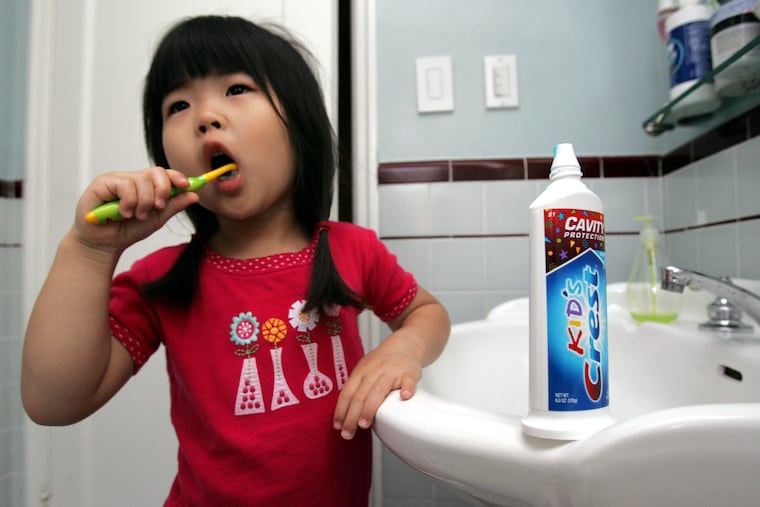Yes, you have to brush your kid’s baby teeth. Even though they’re going to fall out.
Is it really that important for kids to brush baby teeth that are going to fall out anyway?

The most common chronic childhood disease is lurking under the radar of many parents: Dental cavities.
More than half of children between ages 6 and 8 years have had a cavity in at least one baby tooth, and an equal share of kids ages 12 to 19 years old have had a cavity in a permanent tooth, according to the Centers for Disease Control and Prevention. Children from low-income families are twice as likely to develop cavities compared with children from higher-income households.
Here’s what to know about oral care for kids:
When should I first bring my children to the dentist?
By their first birthday. The American Academy of Pediatrics recommends that infants have their first dental check-up six months after their first tooth comes in. Teeth typically start coming in around six months, but some babies (especially girls) may get teeth earlier. After the first visit, children should have routine dental cleanings every six months — just like adults.
What’s the point of treating baby teeth that are going to fall out anyway?
Untreated cavities become painful and can affect your child’s long-term health. Cavities are bacterial infections, which means that as they grow, they can spread to other teeth, said Jason Bresler, who has a doctorate of medicine in dentistry and is part of the Philadelphia-area pediatric practice Doc Bresler’s Cavity Busters.
Children lose their baby teeth over several years — typically between ages 6 and 13 — which means a cavity in a baby tooth could spread to a neighboring adult tooth.
Large cavities can become infected or abscessed, which can lead to facial swelling and hospitalization in severe cases, if the infection spreads enough that it must be treated with IV medications.
A tooth that becomes infected because of an untreated cavity will have to be removed, which can affect the way a child eats and talks, and how their adult teeth come in. Regular dental visits can prevent any problem spots from developing into major dental issues.
How do I reduce the risk of cavities among kids?
Limit sugary foods, and floss and brush before bed.
Candy and sugary snacks significantly increase the risk of cavities. And juice is full of sugar, so don’t give your child more than 4 ounces of it a day.
Tooth-decaying sugar is also in lots of other foods you that don’t expect. Any food that’s high in carbohydrates can increase your chances of decay. Breads, pasta, chips, pretzels, juice, and soda are all cavity culprits. Carbs act as a fuel source for the bacteria in your mouth to create acid that eats away at your teeth, causing cavities.
Opt for fresh snacks, such as fruit and vegetables, or foods that pack a lot of protein, such as string cheese or yogurt, instead of processed foods, which tend to have lots of carbs and sugar.
When should I start helping my child brush teeth?
Start young, be consistent, and brush for young children, Bresler said. Start brushing your child’s teeth when they are an infant to help them get used to the activity and learn that it isn’t painful.
An evening brushing routine may be a struggle at first with toddlers and elementary school-aged children who aren’t accustomed to having to brush, but they will eventually adjust, Bresler said. Rewards, sticker charts, and toothbrushes with fun designs may help to get them excited about brushing.
Don’t let your child brush their own teeth until they’ve demonstrated they have the dexterity to do it and understand the responsibility of brushing daily.
What type of toothbrush is best for children?
A soft-bristle toothbrush is best. “No person, pet or living creature should use more than a soft-bristle toothbrush,” Bresler said. “The only thing a hard bristle brush is good for is cleaning the grout in your bathroom tile.”
Electric toothbrushes may be helpful for children because they can help clean difficult-to-reach spots and most have timers to let kids know when they’ve brushed long enough. But if your child is scared of the noise and vibration, stick to a traditional toothbrush.
Is fluoride toothpaste safe for children?
Yes. All current recommendations for pediatric dental care urge the use of fluoridated toothpaste in the proper amount. Children too young to spit will swallow the toothpaste you use, so apply just a smear — less than the size of a grain of rice — to their brush.
Some parents worry about fluoridated toothpaste because too much fluoride can be toxic. But commercially available toothpastes are formulated so that “even if you ate an entire tube of toothpaste — it would be toxic, but not lethal,” Bresler said.
To be clear, do not eat an entire tube of toothpaste.
But if you are concerned about the amount of toothpaste your child has swallowed, Bresler recommends providing a big glass of milk, which will bind to the fluoride so that it can be excreted, instead of absorbed.